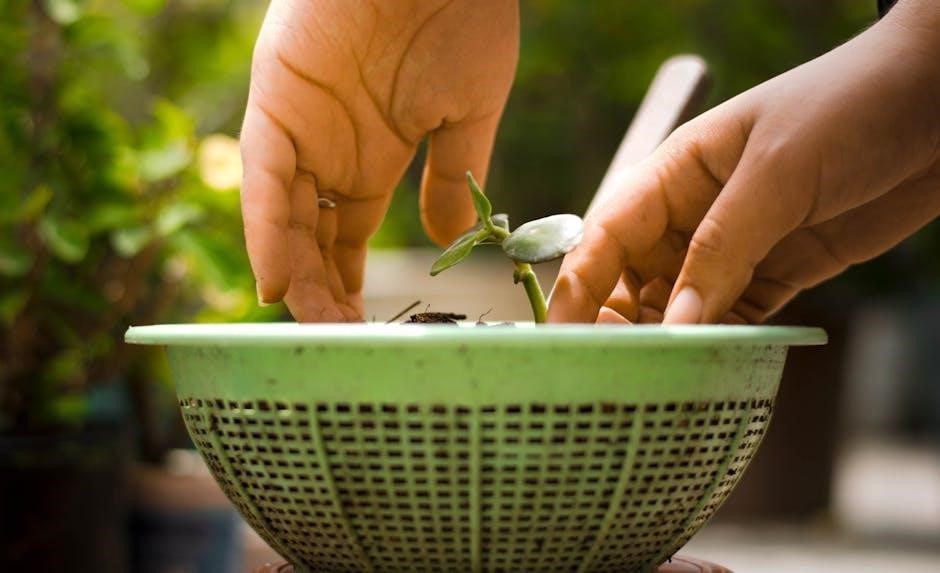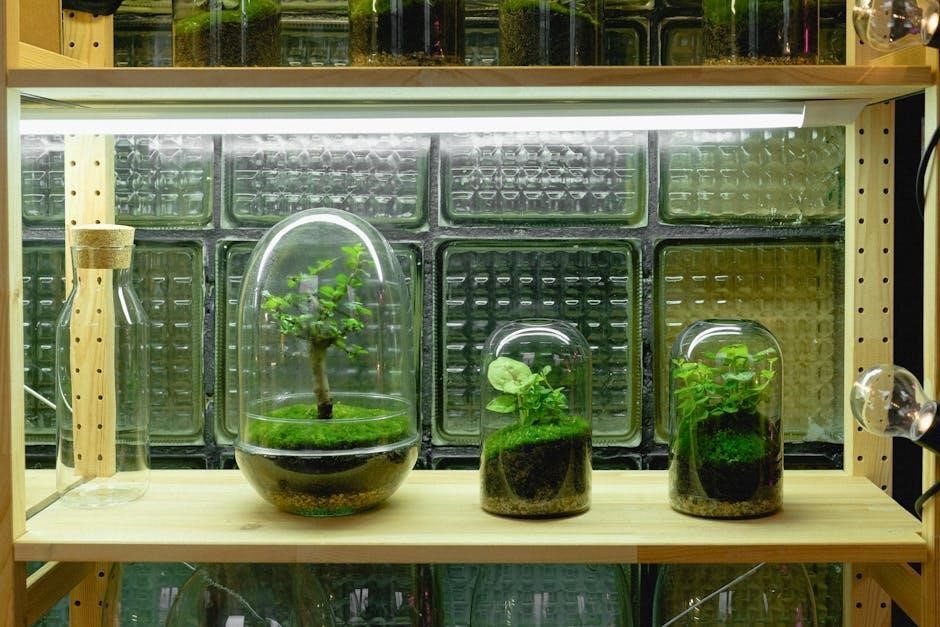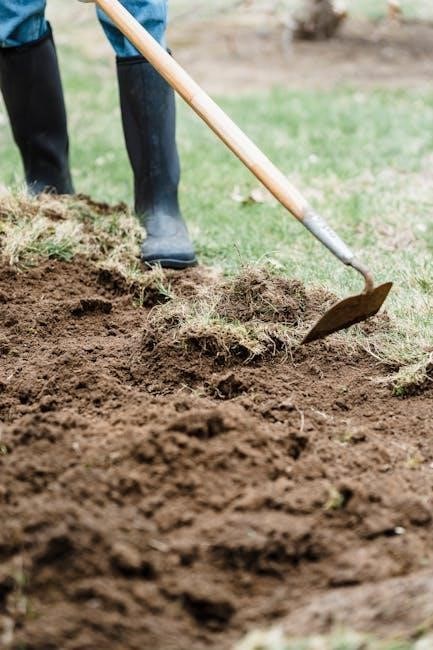Manual soil compaction is a crucial process for stabilizing ground surfaces, ensuring durability, and preventing settlement. It involves using techniques like tamping or watering to densify soil layers effectively.
Overview of Soil Compaction
Soil compaction is the process of densifying soil layers to increase stability and strength. It reduces air pockets, enhancing load-bearing capacity and preventing settlement. Compact soil resists erosion and water penetration, making it ideal for construction and landscaping projects. Manual compaction methods, such as tamping or watering, are cost-effective and suitable for small-scale applications. Proper techniques ensure even density without causing damage to the soil structure. This step is essential for creating a solid foundation for various projects, ensuring long-term durability and performance.
Importance of Manual Compaction
Manual compaction is vital for achieving uniform soil density, especially in small or detail-oriented projects. It ensures a stable base for structures, preventing future settling or shifting. This method is cost-effective, requiring minimal equipment and labor. Manual techniques also allow precise control, reducing the risk of overcompaction, which can damage soil structure. Properly compacted soil enhances drainage, reduces erosion, and creates a durable surface, making it essential for landscaping, gardening, and construction projects where machinery is impractical or unnecessary.
Understanding Soil Types
Soil types vary in texture and composition, with clay, sand, and loam being the primary categories. Each type requires specific compaction methods for optimal results.
Clay Soils
Clay soils are cohesive and dense, holding water well. They require careful handling during manual compaction. To compact clay, ensure the soil is moist but not saturated, as excess water can lead to overcompaction. Use tools like hand tampers or plate compactors to apply pressure in layers. Proper compaction prevents settling and improves stability, making it ideal for construction and landscaping projects. Testing moisture levels before starting is essential for achieving the best results with clay soils.
Sandy Soils
Sandy soils are non-cohesive and drain quickly, requiring specific techniques for effective manual compaction. Moistening the soil slightly enhances compaction, as dry sand is difficult to densify. Use hand tampers or plate compactors in small, repeated layers. Overcompaction can reduce permeability, so careful monitoring is essential. Properly compacted sandy soils provide a stable base for pathways or foundations, ensuring long-term durability and resistance to settling. Regular checks after compaction help maintain the integrity of the surface.
Loamy Soils
Loamy soils, a balanced mix of clay, silt, and sand, are ideal for manual compaction due to their cohesion and water retention. Optimal compaction occurs when the soil is slightly moist but not waterlogged. Use hand tampers or plate compactors in small layers, ensuring even pressure. Overcompaction can reduce soil permeability, so monitor density carefully. The hand test can verify moisture levels: squeeze a handful; if it holds without crumbling, it’s ready. Properly compacted loamy soils provide a stable, durable base for pathways or construction projects.
Preparing the Soil
Preparing the soil involves assessing moisture levels, clearing debris, and creating an even surface. Proper preparation ensures effective compaction and a stable base for projects.
Testing Soil Moisture
Testing soil moisture is essential for effective manual compaction. The soil should be moist but not waterlogged. A simple hand test can determine moisture levels: squeeze a handful of soil. If it holds together without leaking water, the moisture content is ideal for compaction. Proper moisture balance is critical for achieving maximum density and stability in the soil. This step ensures the soil is workable and ready for compaction techniques, optimizing the final result.
Clearing Debris
Clearing debris is a vital step before manual compaction. Remove rocks, roots, and vegetation to ensure even compaction. This prevents uneven surfaces and interference with the process. Use tools like shovels or rakes to eliminate loose material. Proper preparation guarantees better results and prevents damage to tools. A clean surface allows for effective tamping and water distribution, ensuring optimal soil stabilization.

Manual Compaction Techniques
Manual compaction involves methods like tamping by hand or foot, using tools such as hand tampers, and water flooding to densely pack soil for stability and strength.
Using a Hand Tamper
A hand tamper is a simple, effective tool for compacting soil manually. It typically features a flat, heavy plate or surface attached to a handle. To use it, hold the tamper firmly and press it down onto the soil surface repeatedly. This method works well for small areas, such as garden paths or flower beds. For best results, apply consistent pressure and overlap your strokes to ensure even compaction. The tamper’s weight helps push air out of the soil, creating a dense, stable base.
Tamping by Foot
Tamping by foot is a basic yet effective method for manually compacting soil. Simply stand on the soil surface and apply pressure by shifting your weight. Ensure the soil is moist, as dry soil is difficult to compact and overly wet soil may not hold its shape. This technique is ideal for small-scale projects and can be enhanced by tamping in overlapping patterns to achieve uniform density. It’s a cost-effective and labor-intensive approach for creating a stable ground surface.
Water Flooding Method
The water flooding method involves saturating the soil with water to enhance compaction. Gently soak the soil until water pools on the surface, then allow it to absorb for at least an hour before repeating. This technique helps achieve optimal moisture levels, making the soil more receptive to compaction. It’s particularly effective for granular or sandy soils, as water helps fill air pockets and improve density. Ensure the soil isn’t overly saturated, as this can hinder the compaction process. This method is simple yet efficient for small-scale projects.
Tools for Manual Compaction
Essential tools include hand tampers for small-scale projects and plate compactors for larger areas. These tools help achieve uniform density and stability in manually compacted soil effectively.
Hand Tampers
A hand tamper is a versatile tool used for manual soil compaction, ideal for small-scale projects. It typically features a flat, sturdy base attached to a handle, allowing for efficient tamping. By repeatedly pressing the tamper onto the soil surface, air pockets are eliminated, increasing density. Hand tampers are portable and easy to use, making them perfect for tight spaces or DIY projects. Regular cleaning and maintenance ensure optimal performance. This tool is essential for achieving uniform compaction in various soil types, ensuring stability and durability.
Plate Compactors
Plate compactors are heavy-duty tools designed for efficient soil compaction, especially in larger areas. They feature a sturdy, flat steel plate attached to a handle, allowing for powerful manual operation. By lifting and dropping the plate repeatedly, the soil is densely packed, reducing air pockets. Plate compactors are ideal for deeper compaction and are often used in construction and landscaping projects. While they can be physically demanding, they provide superior results compared to hand tampers, making them a valuable asset for manual soil compaction tasks.

Measuring Compaction
Measuring compaction ensures soil density and stability, confirming if manual efforts have achieved desired results. Techniques like field density tests and moisture checks verify effectiveness.
The Hand Test
The hand test is a simple method to assess soil compaction. It involves picking up a handful of soil, squeezing it, and observing its behavior. If the soil holds its shape without crumbling, it indicates proper moisture and compaction. This technique provides immediate feedback, helping determine if further tamping or watering is needed. It’s an effective way to ensure the soil is compacted adequately for stability and strength.
Proctor Test
The Proctor Test is a standardized method to measure soil compaction. It determines the optimal moisture content and density by compacting soil samples in a mold using a tamper. The test involves preparing multiple soil layers and measuring their weight and volume. The results help identify the maximum achievable density, ensuring the soil is compacted to its best potential. This test is essential for verifying the effectiveness of manual compaction techniques and achieving stable, long-lasting results.

Maintaining Compacted Soil
Maintaining compacted soil involves regular monitoring and addressing settling or erosion. It ensures the soil remains stable and retains its structural integrity over time.
Regular Checks
Regular checks ensure compacted soil remains stable and durable. Inspect for signs of settling or erosion, and re-compact areas showing weakness. Moisture levels should be monitored to prevent over-drying or waterlogging, which can compromise soil structure. Use simple tools like hand tampers for minor adjustments and perform these checks after heavy rainfall or prolonged use to maintain integrity. Consistent monitoring helps prevent costly repairs and ensures the soil remains functional for its intended purpose.
Reinforcement Methods
Reinforcement methods enhance soil stability post-compaction. Adding organic matter or gravel improves soil structure and strength. Geotextiles can prevent erosion and distribute load evenly. For clay soils, mixing in sand or lime boosts drainage and durability. Regular watering after compaction helps settle particles further. These methods ensure long-term stability and prevent weakening over time, especially in high-traffic areas or adverse weather conditions.

Safety and Best Practices
Wear protective gear like gloves, safety glasses, and steel-toe boots. Work in stages to avoid fatigue and ensure even compaction. Keep tools well-maintained for efficiency and safety.
Protective Gear
Always wear protective gear when manually compacting soil to prevent injuries. Use sturdy gloves to protect hands from blisters and cuts. Safety glasses or goggles are essential to shield eyes from debris. Wear steel-toe boots or robust footwear to safeguard feet from heavy tools or falling objects; Consider wearing long sleeves and pants to protect skin from abrasions. A dust mask can help avoid inhaling soil particles. Ensure all gear fits properly and is in good condition for optimal protection. Regularly inspect equipment to maintain safety standards and prevent accidents during the compaction process.
Working in Stages
Manual soil compaction is most effective when done in stages. Divide the soil into manageable layers, typically 4-6 inches thick, and compact each layer separately. Start with the bottom layer and work upward, ensuring each section is firmly compacted before moving to the next. This method prevents overcompaction and ensures even density. Allow compacted layers to settle for a short period before proceeding. Repeat the process until the entire area is uniformly compacted. This staged approach ensures stability and prevents soil displacement, making the process efficient and long-lasting.

Testing After Compaction
After compaction, field density tests are conducted to ensure the soil has reached optimal density. This step verifies stability and prevents future settling or structural issues.
Field Density Tests
Field density tests are essential for verifying soil compaction quality. Common methods include the sand replacement and nuclear density gauge tests. These procedures measure the soil’s density in its compacted state. The sand replacement method involves replacing soil with sand to calculate density, while nuclear gauges use radiation to determine moisture and density levels. Both ensure the soil meets design specifications, confirming proper compaction. Accurate results help prevent structural issues and ensure long-term stability of the compacted surface. Regular testing guarantees the effectiveness of manual compaction efforts.

Common Mistakes
Overcompaction can damage soil structure, reducing permeability. Inadequate moisture leads to poor compaction results. Both mistakes compromise soil stability and require costly rework to correct properly.
Overcompaction
Overcompaction occurs when soil is densified beyond its optimal level, causing reduced permeability and root growth. It disrupts soil structure, leading to waterlogging and nutrient deficiencies. Signs include a hard, cracked surface and poor drainage. Proper moisture levels and techniques must be maintained to avoid this issue. Using tools like hand tampers or plate compactors excessively can exacerbate the problem. Regular checks and adjustments during compaction are essential to prevent overcompaction and ensure healthy soil conditions for construction or landscaping projects. Early detection can save time and resources by allowing corrective measures before significant damage occurs. Proper training and adherence to guidelines are key to avoiding overcompaction and achieving desired soil stability. Regular breaks and inspections during manual compaction help maintain optimal soil density without overcompacting. Understanding soil types and their limits is crucial to prevent this common mistake. Overcompaction can lead to long-term soil degradation, making it imperative to follow best practices and monitor progress closely during manual compaction activities. By being mindful of these factors, one can effectively compact soil manually without causing harm.
Inadequate Moisture
Inadequate moisture is a common issue during manual soil compaction, leading to poor density and stability. Dry soil resists compaction, behaving like sand, and may crack or shift under weight. Proper moisture levels are essential for achieving optimal compaction. To identify insufficient moisture, perform the hand test: squeeze a soil sample; if it crumbles easily, it’s too dry. Address this by gently watering the soil and allowing it to absorb before compacting. Ensuring the right moisture balance is critical for effective and long-lasting results in manual compaction processes. Regular checks and adjustments are necessary to maintain ideal conditions. Ignoring moisture levels can result in structural weaknesses and reduced soil stability, making it vital to monitor and correct this issue promptly. Proper hydration ensures soil particles bind effectively, creating a solid foundation for construction or landscaping projects. By addressing inadequate moisture early, one can achieve better compaction outcomes and avoid future complications. Always test and adjust moisture levels before proceeding with manual compaction to ensure the best results. This step is foundational for successful soil stabilization. Consistent moisture management is key to achieving durable and reliable compaction. Neglecting this can lead to costly repairs and project delays, emphasizing the importance of proper preparation. Moisture balance is a critical factor in manual compaction, directly impacting the final outcome and longevity of the stabilized soil; Adjusting moisture levels carefully ensures the soil reaches its maximum density potential, providing a stable base for various applications. Regular monitoring and timely corrections are essential to prevent inadequate moisture from undermining compaction efforts. Understanding and addressing this issue is vital for achieving professional-grade results in manual soil compaction. By prioritizing moisture management, one can ensure the soil is properly prepared for compaction, leading to stronger and more durable surfaces. This attention to detail is what distinguishes successful manual compaction projects from those that fail to meet expectations. Proper moisture levels are the cornerstone of effective soil compaction, and their importance cannot be overstated. Always allocate time to assess and adjust moisture content before beginning the compaction process. This proactive approach significantly enhances the quality and longevity of the final result. Inadequate moisture is a preventable issue that, when addressed correctly, ensures manual compaction is both efficient and effective. By staying vigilant and making necessary adjustments, one can overcome this common challenge and achieve outstanding results. Moisture management is an art that, when mastered, elevates manual compaction from a tedious task to a precise science. It is through careful attention to moisture levels that one can unlock the full potential of manually compacted soil, creating strong and lasting foundations for any project. The importance of adequate moisture in soil compaction cannot be emphasized enough, as it directly influences the outcome and performance of the compacted surface. Always remember that moisture is the key to achieving optimal results in manual compaction. Properly hydrated soil is easier to compact and results in a more stable and durable surface. By addressing inadequate moisture promptly, one can ensure the success of their manual compaction efforts. This fundamental aspect of soil preparation is what sets apart amateur projects from professional-grade work. Moisture management is an essential skill for anyone involved in manual compaction, and mastering it leads to consistently superior results. Always prioritize moisture assessment and adjustment to guarantee the best possible outcomes in your manual compaction endeavors. The time invested in managing moisture levels will pay off in the form of a strong, stable, and long-lasting compacted surface. Inadequate moisture is a solvable problem that, when addressed, ensures the success of manual compaction projects. By staying informed and proactive, one can overcome this challenge and achieve exceptional results. Moisture management is a critical component of manual compaction, and its proper execution is what ensures the soil is stable, durable, and ready for its intended use. Always approach manual compaction with a focus on moisture balance to maximize efficiency and effectiveness. The end result will be a testament to the importance of proper moisture management in achieving professional-grade soil compaction. Taking the time to assess and adjust moisture levels is an investment that yields lasting benefits for any manual compaction project. It is through this attention to detail that one can ensure the soil is perfectly prepared for compaction, leading to outstanding results. Addressing inadequate moisture is not just a step—it’s a necessity for achieving the best possible outcome in manual soil compaction. Moisture management is the backbone of successful compaction, and its proper execution is what separates good results from great ones. Always remember that moisture levels play a pivotal role in determining the success of manual compaction efforts. By managing moisture effectively, one can ensure the soil is compacted to its full potential, resulting in a strong and reliable surface. The importance of adequate moisture in manual compaction cannot be overstated, as it directly impacts the final product’s quality and performance. Stay vigilant, adjust as needed, and reap the rewards of a job well done. Inadequate moisture is a common pitfall, but with the right approach, it can be easily overcome. Prioritize moisture management, and your manual compaction projects will thrive as a result. The perfect balance of moisture is what unlocks the full potential of manually compacted soil, ensuring it meets all desired specifications. By focusing on moisture management, one can elevate their manual compaction skills and deliver exceptional results consistently. Moisture is the unsung hero of soil compaction, and its proper management is what makes all the difference. Always remember to assess and adjust moisture levels for optimal compaction outcomes. The effort put into moisture management will be reflected in the quality and durability of the compacted surface. Inadequate moisture is a challenge that can be readily addressed with the right techniques and attention to detail. By prioritizing moisture management, one can ensure their manual compaction efforts yield the desired results. Proper moisture levels are the foundation upon which successful compaction is built, and their importance should never be underestimated. Moisture management is a critical aspect of manual compaction, and mastering it is essential for achieving professional-grade results. Always allocate time to assess and adjust moisture levels, as this step is crucial for ensuring the soil is compacted effectively. The final product will speak volumes about the care taken during the moisture management phase. Addressing inadequate moisture is not just about fixing a problem—it’s about creating a stable and durable surface that withstands the test of time. By managing moisture levels effectively, one can ensure their manual compaction projects are both successful and long-lasting. The role of moisture in soil compaction is undeniable, and its proper management is what sets exceptional results apart from mediocre ones. Always approach manual compaction with a keen eye on moisture levels to achieve the best possible outcome. Proper moisture management is the key to unlocking the full potential of manually compacted soil, ensuring it is stable, strong, and ready for use. By staying proactive and addressing inadequate moisture promptly, one can guarantee the success of their compaction efforts. The time and effort invested in moisture management will be evident in the quality of the final product. Inadequate moisture is a preventable issue that, when addressed, ensures manual compaction is both efficient and effective. By prioritizing moisture management, one can overcome this common challenge and achieve outstanding results. Moisture is the cornerstone of successful manual compaction, and its proper management is what ensures the soil is compacted to its full potential. Always remember to assess and adjust moisture levels for optimal results. The rewards of proper moisture management far outweigh the effort required, resulting in a strong and reliable compacted surface. Addressing inadequate moisture is essential for achieving the best possible outcomes in manual compaction. By staying informed and proactive, one can master this critical aspect of soil preparation and deliver exceptional results. Moisture management is a vital skill for anyone involved in manual compaction, and its proper execution is what ensures the final product meets all expectations. Always prioritize moisture assessment and adjustment to guarantee the success of your manual compaction projects. The attention to detail invested in moisture management will pay off in the form of a durable and stable surface. Inadequate moisture is a solvable problem that, when addressed, ensures the success of manual compaction efforts. By managing moisture levels effectively, one can achieve professional-grade results and create a lasting foundation for any project. The importance of proper moisture management in manual compaction cannot be overstated, as it directly influences the quality
Manual soil compaction is a straightforward yet effective technique for stabilizing soil, essential for construction, landscaping, and various projects. By understanding soil types, maintaining proper moisture levels, and using tools like hand tampers or plate compacters, one can achieve optimal compaction. Regular checks and tests, such as the hand test or Proctor test, ensure the soil meets required standards. While labor-intensive, manual compaction offers precise control and cost-effectiveness, making it a valuable method for achieving stable, long-lasting results. With patience and attention to detail, anyone can master manual soil compaction for successful project outcomes.
